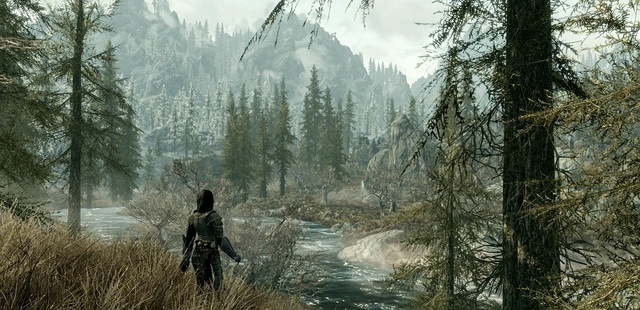
Open-world games often share common design trends: a large area to explore freely, individuals or wildlife to interact with, and a lot of things to do. These are obvious, but there are less apparent tricks devs use to really help to develop the game world and give the player a sense of size and scale.
This is critical in world-building and developing an atmosphere, and it works in conjunction with giving the player a sense of how small they are in this world. Here are four games that use clever tricks to give us that open-world feeling.

Xenoblade Chronicles
Xenoblade was one of the last great games to come out at the tail-end of the Wii's lifecycle, and for good reason. It boasted a great story and characters, fantastic battle system, incredible music, and a gigantic open world with a lot of quests to do and enemies to fight.
How the game demonstrates the massive size of Bionis (which is literally a massive god that the characters live on) is simply a matter of movement. In Xenoblade, the party member you are controlling has a running speed that isn't too slow, but not too fast. This is genius in that it does not allow you to arrive at your next point too quickly, giving you time to soak in the vastness of Bionis. By soaking in the sights, players get a more detailed look at the game world, allowing for a more complete realization of its size.
It also makes what populates Bionis more apparent, which will make it more likely for players to encounter enemies, quests, or items. Since you're taking your time to see the sights, there's a better chance you'll notice something that will get you distracted from the main quest, rather than quickly rushing to your destination.

Batman Arkham City
Batman: Arkham City traded the small corridors of Arkham Asylum for the tall buildings and long streets of Gotham City. However, it's a quarantined area of Gotham meant for criminals (and Batman). Rocksteady designed it accordingly to capture that feeling of containment while simultaneously making it feel like it was once part of Gotham. Buildings are towering and packed closely together. The streets may be long, but they are thin and and tight, with many different turns into other streets.
From afar, it looks like just an average city, but the closer the player gets to the buildings and the ground, the world starts to give off a feeling of everything being cramped together. Even when you're grappling and gliding above the city, the buildings still give a feeling a lack of space. You get the sense that there is something larger out there, but you're cramped in a small part of it.
By doing this, Rocksteady maintains that this is Gotham City, while making players feel the claustrophobia of quarantine. Quarantine in real life has a distinct feeling of being trapped while in a large area, and Rocksteady successfully replicated it in a video game.

Grand Theft Auto V
GTA V creates an amazing and beautiful replica of Los Angeles for players to explore (or, in typical GTA fashion, create chaos in). The game gives players a sense of the scale of Los Santos in a way that works directly with the mechanic of having 3 playable characters: Michael, Franklin, and Trevor.
You can switch from your current character to a different one at any time, and often you'll experience the lifestyle of that character and the community he lives in. Michael's is the filthy rich urban crowd. Franklin lives in the unstable African-American community filled with gangs. Trevor is part the complete and total insanity that is the hillbilly redneck crowd.
By showing different communities and types of people, with different positions on the class ladder, the game creates the idea that Los Santos could be an actual city. It establishes a variety between the groups of people living in Los Santos, creating a realistic population for the city environment.

Fallout 3
It's become standard in Fallout and Elder Scrolls games to start in a confined area, and then to be cut loose and dramatically enter the large open world. But in no other game was this done better than in Fallout 3. During Fallout 3's tutorial/intro, you are simply told what to do and herded into specific areas of a confined vault without much choice at all. You don't feel like an individual, you just feel like part of the entire vault population. You are born, you grow up, take a test, get a job, have kids, whatever. Through dialogue options, your character can express frustration at being stuck in the vault, all connecting to the theme of being trapped.
Once Vault 101 breaks out into chaos, you make your escape. After a short loading screen, you're immediately blinded by searing light. As your sight slowly comes back, you see the vastness of the Capital Wasteland in its entirety.
What makes this short scene so effective is that it, in a few seconds, it creates a clear contrast between the confinement and boredom of a vault and the freedom of the large wasteland. No longer forced into a routine, you are free to explore the wasteland and make your own choices. It doesn't just show you a small part of the open world, it shows you nearly all of it. Despite the fact that the wasteland is drab and barren, the way it's presented in its full glory makes it far more appealing then being stuck in a Vault. This feeling is constant throughout the game, and the urge to explore the wasteland keeps players going in an otherwise desolate, dark land. Design choices like this really help to give game worlds a sense of scale.
What other tricks have you seen developers use to give a sense of scale to their open world games? Let us know in the comments!







Published: Jul 4, 2015 01:01 pm